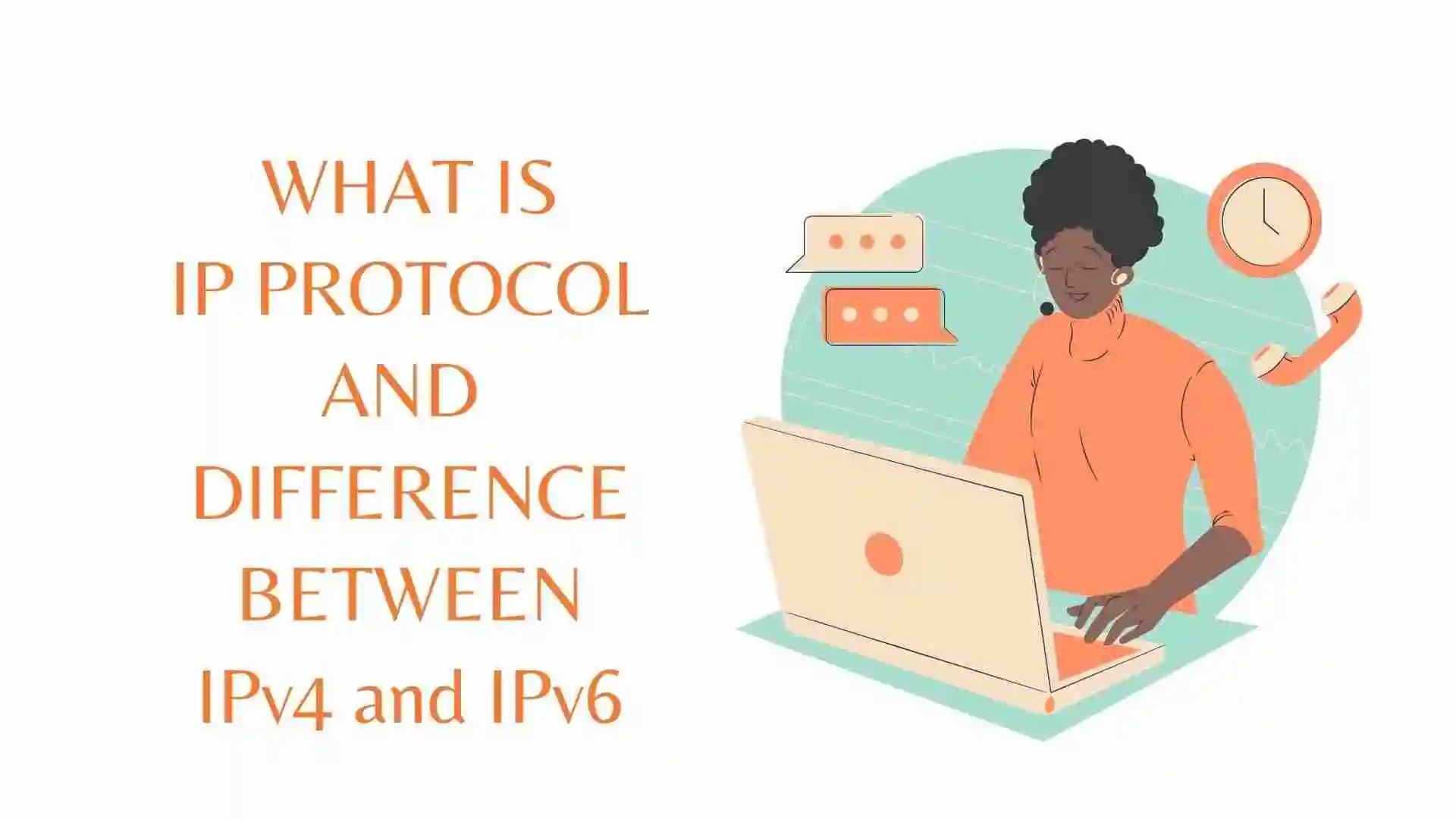In this blog, we learn about the Internet Protocol, i.e., IP. We will see what the function is, its advantages, and its disadvantages. How IP works and its types So let’s get started with the blog.
Table of Contents
- Introduction
- History
- Functions
- How does the IP routing perform?
- What is IP Addressing?
- IPv4 Address
- IPv6 Address
- IPv4 vs IPv6 Address
- FAQ
- Recent Articles on Computer Networks
- Related Articles to Python
Introduction
Internet Protocol (IP) is a fundamental communication protocol used for transmitting data over the Internet. It is a set of rules and procedures that govern the transmission of data between different devices connected to the Internet.
IP is responsible for the routing of data packets between different networks and for ensuring that the packets reach their intended destination.
An IP address, or Internet Protocol address, is a unique numerical identifier assigned to every device that is connected to the Internet.
IP addresses are used to identify and communicate with devices on a network, including computers, smartphones, and other internet-enabled devices.
IP addresses are essential for enabling devices to communicate with each other over the internet, and they are a fundamental component of the underlying technology that powers the internet.
Without IP addresses, devices would not be able to connect to the internet and communicate with other devices and services on the network.
History
The origins of IP can be traced back to the 1960s, when the U.S. Department of Defense developed the ARPANET, which was the first operational packet-switched network. The ARPANET used the Network Control Program (NCP) to control the flow of data between different nodes in the network. In the 1970s, the TCP/IP protocol was developed, which replaced the NCP and became the standard protocol for the ARPANET.
TCP/IP was designed to provide a reliable and efficient means of transmitting data over a network. It is a two-layer protocol that consists of the Internet Protocol (IP) and the Transmission Control Protocol (TCP). The IP layer is responsible for the routing of data packets between different networks, while the TCP layer provides reliable, end-to-end communication between two nodes.
In the 1980s, the TCP/IP protocol became the standard for the Internet, which was a global network of interconnected networks. Today, the Internet has become an integral part of modern society, and IP has played a significant role in its development and growth.
Functions
The Internet Protocol (IP) is responsible for the routing of data packets between different networks and for ensuring that the packets reach their intended destination. The main functions of IP are as follows:
Addressing:
IP provides a unique numerical identifier called the IP address to each device connected to the Internet. This address is used to identify the source and destination of data packets transmitted over the Internet.
Fragmentation and Reassembly:
IP packets have a maximum size limit, and if a packet exceeds this limit, it must be fragmented into smaller packets for transmission. IP is responsible for fragmenting and reassembling these packets to ensure that they are transmitted and received correctly.
Routing:
IP routing is the process of forwarding data packets between different networks. When a device sends a packet to another device, the packet is first sent to the default gateway, which is a device that connects the local network to the Internet. The default gateway is responsible for forwarding the packet to the destination network.
Error Detection and Correction:
IP includes mechanisms to detect errors in data packets and to retransmit them if necessary. This helps to ensure that data is transmitted and received correctly.
Quality of Service:
IP can be used to prioritize certain types of traffic over others. This is done using Quality of Service (QoS) mechanisms, which allow network administrators to allocate bandwidth and ensure that critical applications receive the necessary resources.
Security:
IP security protocols, such as Internet Protocol Security (IPSec), are used to protect the confidentiality, integrity, and authenticity of data transmitted over the Internet. IPSec provides a suite of protocols that are used to encrypt and authenticate IP packets.
Multicasting:
IP multicasting is a feature of IP that allows a single packet to be sent to multiple devices simultaneously. This is useful for applications that require real-time communication, such as video conferencing and online gaming.
Overall, IP plays a crucial role in the functioning of the Internet. Without IP, it would be impossible to transmit data between different networks and connect devices to the Internet. IP enables the reliable and efficient transmission of data over the Internet, and it provides mechanisms for addressing, routing, error detection and correction, quality of service, security, and multicasting.
How does the IP routing perform?
Internet Protocol (IP) routing is the process of forwarding data packets from one network to another based on their IP addresses. It is an essential component of the Internet’s architecture, enabling communication between devices connected to different networks.
IP routing works by using a routing table, which is a database that contains information about the various networks and devices connected to them. Each device connected to a network has a unique IP address, which identifies it on the network. When a device sends a data packet to another device, the packet is forwarded from one router to another until it reaches its destination.
The routing table contains information about the networks and devices connected to each router, as well as information about the best route to take to reach a particular network or device. When a router receives a data packet, it examines the destination IP address and looks it up in its routing table to determine the best path to forward the packet. The router then forwards the packet to the next hop router along the path until it reaches its final destination.
IP routing protocols are used to manage and update the routing tables in real time. These protocols enable routers to communicate with each other and exchange information about network topology and available routes. The most commonly used IP routing protocols are the Routing Information Protocol (RIP), Open Shortest Path First (OSPF), and Border Gateway Protocol (BGP).
Overall, IP routing is a complex process that involves multiple layers of network infrastructure and protocols working together to enable reliable communication across the Internet.
What is IP Addressing?
Internet Protocol (IP) addressing is a system for assigning unique numerical identifiers to devices connected to a network. The IP address is used to identify the location of a device on the network, and it enables communication between devices.
An IP address is a 32-bit number, represented in decimal form, that is divided into four 8-bit segments called octets.
Each octet is separated by a period, creating the familiar dotted-decimal notation (e.g., 192.168.1.1). IP addresses are classified into different classes based on the number of bits used to represent the network and host portions of the address.
IP addressing is essential to the proper functioning of the Internet, as it enables devices to communicate with each other over a network.
When a device sends a data packet, it includes the IP address of the destination device in the packet header. Routers use this information to forward the packet to the correct destination.
There are two types of IP Addressing:
- IPv4 Address
- IPv6 Address
IPv4 Address
An IPv4 address is a numerical label assigned to every device connected to the Internet that uses Internet Protocol Version 4 (IPv4) for communication.
An IPv4 address is a 32-bit address and is typically expressed in dotted-decimal notation, which consists of four groups of numbers separated by dots. Each group represents eight bits, or one byte, of the address.
An example of an IPv4 address is 192.168.0.1.
Drawbacks of IPv4 Addresses:
One of the main drawbacks of IPv4 addresses is that there is a limited number of unique addresses available. With IPv4, there are only about 4.3 billion possible addresses, which may seem like a lot, but with the proliferation of internet-connected devices, this number is becoming increasingly insufficient.
Another drawback is that IPv4 addresses are often subject to address conflicts, where two devices are assigned the same IP address, leading to network connectivity issues.
Additionally, the process of assigning and managing IPv4 addresses is often complex and can be time-consuming, especially for large networks.
To address these issues, IPv6 was developed, which provides a much larger number of unique addresses and simplifies the process of address assignment and management.
IPv6 Address
An IPv6 address is a numerical label assigned to every device connected to the Internet that uses the Internet Protocol version 6 (IPv6) for communication. Unlike IPv4, which uses a 32-bit address, IPv6 uses a 128-bit address, allowing for a much larger number of unique addresses.
IPv6 addresses are typically expressed in hexadecimal notation, consisting of eight groups of four hexadecimal digits separated by colons. Leading zeros in each group may be omitted, and consecutive groups of zeros may be represented with a double colon (::).
An example of an IPv6 address is 2001:0db8:85a3:0000:0000:8a2e:0370:7334.
IPv4 vs IPv6 Address
| IPv4 | IPv6 |
|---|---|
| IPv6 is an alphanumeric address that consists of 8 fields, which are separated by a colon. | It is a 128-bit address |
| It is a numeric address that consists of 4 fields that are separated by a dot (.). | IPv6 is an alphanumeric address that consists of 8 fields, which are separated by colon. |
| In this, the IP address is represented by a decimal. | In this, the IP address is represented by hexadecimal. |
| The Checksum field is available. | The checksum field is not available. |
| It is broadcasting. | On the other hand, IPv6 is multicasting, which provides efficient network operations. |
| It does not provide encryption and authentication. | It provides encryption and authentication. |
FAQ
Internet Protocol (IP) is a fundamental communication protocol used for transmitting data over the Internet. It is a set of rules and procedures that govern the transmission of data between different devices connected to the Internet.
IP is responsible for the routing of data packets between different networks and for ensuring that the packets reach their intended destination.
An IPv4 address is a numerical label assigned to every device connected to the Internet that uses the Internet Protocol version 4 (IPv4) for communication.
An IPv4 address is a 32-bit address and is typically expressed in dotted-decimal notation, which consists of four groups of numbers separated by dots. Each group represents eight bits, or one byte, of the address.
An example of an IPv4 address is 192.168.0.1
An IPv6 address is a numerical label assigned to every device connected to the Internet that uses the Internet Protocol version 6 (IPv6) for communication. Unlike IPv4, which uses a 32-bit address, IPv6 uses a 128-bit address, allowing for a much larger number of unique addresses.
IPv6 addresses are typically expressed in hexadecimal notation, consisting of eight groups of four hexadecimal digits separated by colons. Leading zeros in each group may be omitted, and consecutive groups of zeros may be represented with a double colon (::).
Recent Articles on Computer Networks
- Introduction to Computer Networking | What is Computer Network
- What are Topology & Types of Topology in Computer Network
- What is FootPrinting in Cyber Security and its Types, Purpose
- Introduction to Cloud Computing | What is Cloud Computing
- Distributed Shared Memory and its advantages and Disadvantages
- What is VPN? How doe VPN Work? What VPN should I use?
- What is an Internet and How the Internet Works
- What is a Website and How Does a Website or web work?
- Introduction to Virus and different types of Viruses in Computer
- What is TCP and its Types and What is TCP three-way Handshake
- What is UDP Protocol? How does it work and what are its advantages?
Related Articles to Python
- Continue and Break Statement in Python
- Definition of Strings in Python with its Examples
- Numbers in Python | Introduction to Numbers in Python
- Loop in Python | Different Types of Loop in Python
- Sets in Python | Python Sets and Operations performs on them
- Conditional Statements in Python (With Examples)
- File Handling in Python and Operations performed on File Handling
- What are Dictionary in Python | Dictionary in Python, advantages
- Variables and Typecasting in Python || Variables in Python



